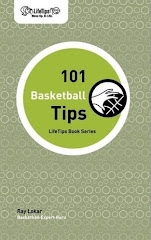During the preseason, as basketball coaches are introducing the offensive and defensive game plans, philosophies, and strategies, it is easy to forget some basic actions that can improve players and the team. There are some fundamental things that ANY player can commit to doing, simply by putting their mind to it, without needing to get better at any "basketball fundamentals". These "commitments" can make the player more effective IMMEDIATELY without getting any better at “basketball skills”.
➢ PLAY WITH YOUR KNEES BENT.
Always stay in an athletic stance. It is your point of maximum explosion. Be just like a track sprinter coming out of the blocks. Have your knees bent. Be on balance. Be ready to move. You will get open on offense more often. You will guard your man on defense easier. The player with the lowest active stance usually wins.
➢ GET A HAND UP ON EVERY SHOOTER
The only person who can score is the one with the ball. Go guard him even if he is not your man. Help your teammates when their man is open. Go guard him. Contest the shot even if it means leaving your feet, but don’t fall for a head fake too easily!
➢ GAIN POSSESSION WITH TWO HANDS
Always catch the ball with 2 hands--concentrate on the catch before you do anything else. Rebound with 2 hands--and try for every one. Pick up a loose ball with 2 hands--pick it up, don’t dribble it. You will get more possessions for your team and each possession is another chance to score.
➢ TRY TO OUT RUN YOUR OPPONENT EVERY TIME
You will usually break their will with your first three steps. Get ahead of the defense and your teammates will throw you the ball. It will help you get easy shots on offense with your fast break. If you beat the offense back, they may not even try to run their fast break. Getting back on defense will help stop their fast break and cut down on their easy shot attempts.
➢ PASS TO THE FIRST OPEN PERSON
Passing the ball is faster than dribbling it. If you move the ball, you make the defense adjust and they might make a mistake and leave someone (maybe you!) open. If you see an open teammate--throw them the ball. Don’t wait for a better pass. Remember - "a bird in the hand is worth two in the bush."
There are some more "little things" that you can do to be a more effective player for your team.
➢ OFFENSIVE EXTRAS
Establish a pivot foot
When you catch the ball, plant one foot and establish a pivot foot. Now that you have a pivot foot you can use the other foot for a "rocker move" that can fake out a defender, set up another move, or to create a better passing angle.
Face the basket
When you catch the basketball, turn & face the basket, read the defense and make a move on the catch if it is there. If not get into "triple threat position". This is the position that you will be able to shoot, pass, or dribble from. Then the defense has more things to worry about and you will be hard to guard.
Dribble for a reason
If you dribble the basketball, only dribble for a good reason. Good reasons to dribble are: to dribble the ball up the floor, to drive to the basket, to get in better position to make a pass, or to relieve some defensive pressure.
Good shot or Bad shot?
Don’t ever surprise anyone with your shot. If your teammates and coach expect you to shoot, it’s probably a shot that they think you can make. They also will be ready for an offensive rebound or to get back on defense. That makes it a good shot. A rebound gives your team another chance to score. If your team is not back on defense, you might give up an easy fast break basket to the other team.
➢ DEFENSIVE EXTRAS
Pressure on the Basketball
Always try to put defensive pressure on the player with the basketball. Pressure makes the offense worry more about the defense than what they are supposed to do in their offense. Rick Majerus, when he was the coach at the University of Utah, said that pressure is when the referee is counting. If the defense is within 6 feet, the offense can only hold the ball for 5 seconds each. Play close enough to the ball to try to get a "5 second count"
Jump to the pass
When you are on defense, every time someone passes the basketball, take a few steps in the direction that it is thrown. This will put you in a position to stop your man if he tries to cut to the basket. You also will be in the right spot to help your teammates, if their man dribbles by them.
See your man and the basketball
Always be able to see your man & the man with the basketball. You need to be able stop your man AND help your teammates if they get beat on the dribble.
Stop the basketball
When on defense, react to the basketball and help your teammates. The only man that can score is the man with the ball. If he’s open - go guard him. If he passes the ball back to your man, sprint back and be ready to pressure him again.
➢ THE BOTTOM LINE
On offense, make sure that your team gets a shot every time.
On defense contest every shot the other team takes.
GET READY FOR GAME 7
-
The Indiana Pacers avoided an end to their season beating the New York
Knicks Friday night in Indy, 116-103. The series is tied 3-3. Game 7 is
Sunday, 3:30...
7 hours ago









